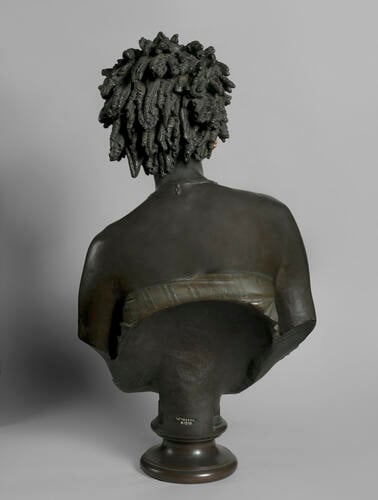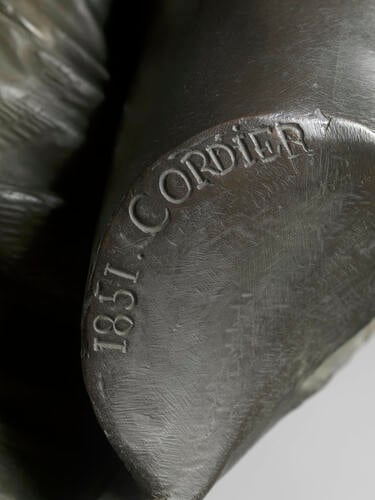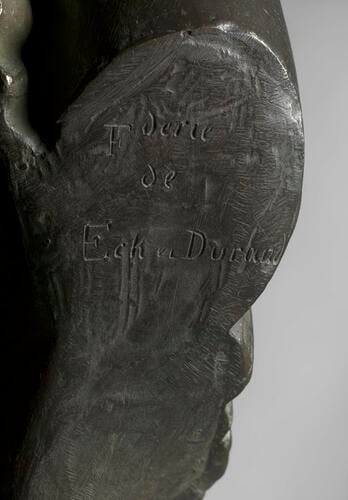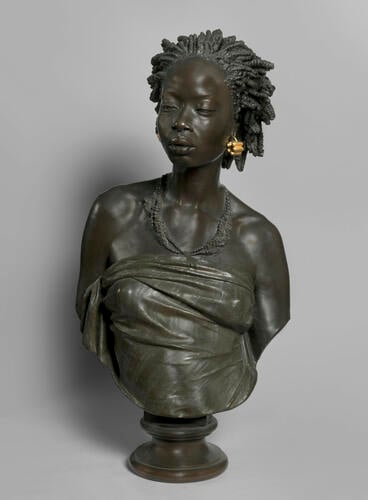-
1 of 253523 objects
Vénus africaine 1852
Bronze | 82.0 x 45.0 x 33.0 cm (excluding base/stand) | RCIN 41510

Charles Cordier (1827-1905)
Vénus africaine 1852

Charles Cordier (1827-1905)
Vénus africaine 1852

Charles Cordier (1827-1905)
Vénus africaine 1852




-
A bronze bust of an African woman, looking slightly to the left, her shoulders slouched; wearing a striped cloth about her torso, with a coral beaded necklace and a gilt earring in her right ear; short hair; on a circular socle.
This bust was acquired by Queen Victoria in September 1852, along with its pair Saïd Abdallah (RCIN 41509), having been sold by the sculptor, Cordier, in June to the dealer Peter Graham, partner in the leading London furnishing firm Jackson & Graham.
Images of distant peoples became increasingly familiar to Europeans from the 1840s through the spread of photography and as the result of anthropological studies made in the course of scientific expeditions. These often included the measurement of the heads of Indigenous peoples and frequently the preparation of plaster casts ‘from the life’ for the study of phrenology. Proponents of phrenology argued that the shape of the skull was indicative of psychological and mental faculties, a psuedoscientific approach now wholly discredited by modern research.
The sculptor Charles Cordier was among the first to recognise the artistic as well as the scientific potential of such subjects. His busts of anonymous African and Far Eastern sitters challenged Western ideals of beauty. The son of a pharmacist from Cambrai in north-eastern France, he came to settle in Paris in around 1845 and entered the studio of François Rude. It was there that he encountered Saïd Enkess, a formerly enslaved man from Sudan, and decided to make his portrait (Saïd Abdallah).
From Cordier's original, spontaneous portrait of Saïd there emerged in the course of three years a pair of ‘ideal’ heads - Saïd Abdallah and Vénus africaine. The critic of the Paris journal l'Artiste noted that although the Vénus may have been modelled from the life, every perceived imperfection in her features had been ironed out. Casts of both busts were commissioned in the same year by the French government for inclusion in the ethnographic collections of the Muséum d'Histoire naturelle in Paris.
At least eighteen full-size versions and numerous small reductions of the busts are known, some finished with gilding, silvering and enamels. The drapery of both Royal Collection busts was described in the 1873 Osborne inventory as silvered, but there is no longer any trace of this treatment on either.
Text adapted from Victoria & Albert: Art & Love.Provenance
Purchased by Queen Victoria (payment dated 13 September 1852, £201 5s for a pair of busts including Vénus, RA QV Journal 1852/121) through Messrs. Jackson & Graham;
Given to Prince Albert by Queen Victoria, 24th December 1852 [Victoria & Albert: Art & Love, London, 2010, pg 460]
-
Creator(s)
(sculptor)(nationality)Acquirer(s)
-
Medium and techniques
Bronze
Measurements
82.0 x 45.0 x 33.0 cm (excluding base/stand)
Category
Object type(s)